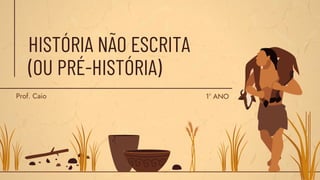±Ê¸éÃ-±á±õ³§°ÕÍѸé±õ´¡.±è±è³Ù³æ
- 1. HISTÃRIA NÃO ESCRITA (OU PRÃ-HISTÃRIA) 1° ANO Prof. Caio
- 2. A EVOLUÃÃO DOS HOMINÃDEOS ATÃ O HOMEM ATUAL
- 3. O DESENVOLVIMENTO DO CÃREBRO DO HOMO SAPIENS
- 4. ÃREAS DE DESCOBERTAS DE FÃSSEIS DE HOMINÃDEOS
- 6. PaleolÃtico (aprox. 3.500.000 - 10.000a.C) Significado: Pedra Lascada (pedra antiga, em grego) = matéria prima fundamental para a elaboração de artefatos. Atividades mais importantes: caça, pesca e coleta de vegetais (sociedades caçadoras/coletoras). Construção técnica: domÃnio do fogo e de instrumentos (ossos, madeiras e depois pedra lascada). Estilo de vida: Nômade = busca de alimentos, água e âmoradiaâ). Produção cultural: pinturas rupestres em paredes cavernas.
- 7. PaleolÃtico (aprox. 3.500.000 - 10.000a.C) ï¼ O homem vai descobrindo meios de dominar a natureza ï¼ Vive em pequenos grupos nômades e se abriga em cavernas. ï¼ Desenvolve a linguagem para se comunicar. ï¼ Fabrica anzóis e agulhas de osso, arco e flecha de madeira. ï¼ Usa trajes de pele para se abrigar do frio. ï¼ Usa o fogo para cozimento de alimentos e defesa contra animais. ï¼ Inicia a arte (pinturas) nas cavernas
- 8. ARTE RUPESTRE (FEITA EM CAVERNAS) Lascaux: cavernas ao sudoeste da França, Arte: paredes pintadas com bovÃdeos, cavalos, Cervos, cabras selvagens, felinos, entre outros animais. Datação: 17.000 anos AP (Antes do presente).
- 11. A PICTURE IS WORTH A THOUSAND WORDS
- 12. ANALYSIS & DEVELOPMENT Neptune is very far away from the Sun Saturn was named after a Roman god Jupiter doesnât have a solid surface PHASE 01 PHASE 02 PHASE 03 Mars is full of iron oxide dust Earth is the third planet from the Sun Venus has extremely high temperatures PHASE 04 PHASE 05 PHASE 06
- 13. MAIN HUMAN REMAINS ASIA Neptune is the farthest planet from the Sun AFRICA Mercury is the closest planet to the Sun EUROPE Saturn was named after a Roman god
- 14. DISCUSSION Despite being red, Mars is actually a cold place. It's full of iron oxide dust, which gives the planet its reddish cast. Earth is the third planet from the Sun and the only one that harbors life in the Solar System. This is where we all live: â Ceres is located in the main asteroid belt â The Moon is Earthâs natural satellite â Neptune is very far away from us â Pluto now considered a dwarf planet TOPIC DISCUSSION 1 Mercury is the closest planet to the Sun and the smallest one in the Solar Systemâitâs only a bit larger than the Moon DISCUSSION 2 Venus has a beautiful name and is the second planet from the Sun. Itâs terribly hotâeven hotter than Mercury
- 15. 100,000 years old are the oldest archeological remains of humans
- 16. MORE INFORMATION â Neptune is the farthest planet in our Solar System. Itâs the fourth- largest one by diameter â The Moon is the natural satellite orbiting Earth and is the planet's only natural satellite â Earth is the third planet from the Sun and the only planet known to harbor life â Despite being red, Mars is a cold place. The planet is full of iron oxide dust â Mercury is the closest planet to the Sun and the smallest one in the Solar System â Venus has a beautiful name and is the second planet from the Sun. Itâs terribly hot INFORMATION A INFORMATION B
- 17. CREDITS: This presentation template was created by ºİºİߣsgo, and includes icons by Flaticon, and infographics & images by Freepik THANKS! DO YOU HAVE ANY QUESTIONS? youremail@freepik.com | +34 654 321 432 | yourwebsite.com Please keep this slide for attribution
- 18. ALTERNATIVE RESOURCES Hereâs an assortment of alternative resources whose style fits the one of this template: VECTORS â Primitive people big set

















